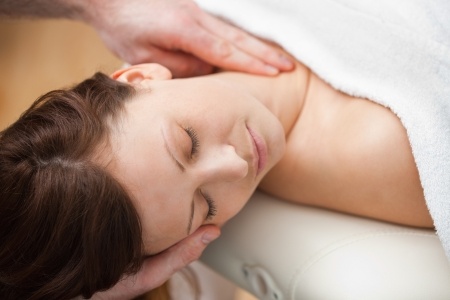Craniosacral therapy works to help release constrictions, tension, misalignment, and trauma from the fascia: the body’s connective tissue.
The fascia (or ‘facia’) tissue is the ‘glue’ that holds our bodies together. It directly holds together our skin, muscles, bones, organs, blood and nerve vessels, and sheaths all our muscle tissue. It is one continuous, interconnected structure throughout the body. It literally keeps us ‘whole’.
It is truly amazing in it’s ability to allow our bodies huge flexibility, whilst also having the strength to protect our most vital organs during a serious injury.
Throughout life the fascia can become impacted by parts of our physical and emotional history: our knocks and bangs, stresses and strains dating back to our birth experiences and our fetal selves! Illness, shock, accidents, toxins, congenital conditions, surgery and our upbringing can all leave their marks on our fascia.
 Upledger Craniosacral therapy aims to brings the body’s awareness to the impacted areas in a very gentle prescribed way that naturally encourages release, integration and healing.
Upledger Craniosacral therapy aims to brings the body’s awareness to the impacted areas in a very gentle prescribed way that naturally encourages release, integration and healing.
The experience of receiving craniosacral therapy differs from massage, which works primarily with the muscles, and chiropractics and osteopathy which both work primarily with the bone structure.
Craniosacral therapy is usually received fully clothed, on a therapists couch, and usually in the quiet. If you would be more comfortable in a different position, let me know.
Most of the holds use very light pressure. Fascia is thixotropic: it resists fast and hard movements (providing protection to the body), but becomes malleable to slow and gentle pressure, allowing it to become flexible and pliable, enabling structural releases.
Facial release can be enormously beneficial.
On a physical level, releasing facial constrictions may be able to help improve ones mobility, improve organ function, improve blood supply, and improve nerve efficiency (eg. help neuralgic and motor coordination problems).
Craniosacral therapy can help brain functioning. The fascia provides a pivotal roll in protecting the central nervous system and keeping it’s surroundings very tightly controlled: from the brain in the cranium (skull), along the spinal canal to the the sacrum (pelvis). Any beneficial work done to the fascia surrounding or connected to the spinal chord and brain should have a beneficial effect on ones body’s control systems, it’s chemical, hormone and endocrine systems, supporting ones whole physique and emotional well being.
Different parts of the brain can also be worked upon directly. The relatively unique training that craniosacral therapists have: to feel through the more external organs to work on the inner ones, is as applicable to the brain as to the rest of the body.
Unfortunately the name ‘craniosacral’ therapy can be a little misleading: the therapy works well with all parts of the body. Not to be confused with cranial osteopathy that works mainly on the head.
Because of the interconnectedness of the fascia, when the fascia is released in one part of the body, it often has beneficial knock on effects on the rest of the fascia and body systems. Many times in craniosacral therapy, the origin of a problem can be traced, or ‘referred’ to a different part to where it is felt. Any releases on any part of our trunk or lower body has the potential to allow releases in other parts of our body and in our central nervous system.
Interestingly, with craniosacral therapy, there appears little difference working with problems whether they originated recently, or from any time in ones past!
Somatoemotional Release
The condition of the fascia can physically effect how we ‘feel’ at any particular moment.
Different parts of our bodies are used to tensing or relaxing in certain emotional situations. This is largely subconscious, often related to buried memories. With craniosacral treatment (or other appropriate practices), these memories can be brought gently into the conscious. These awarenesses on their own may start to change how we ‘feel’ or react in certain situations. More work can then be done to release tensions and connect more deeply to the causes of our reactions, promoting understanding and acceptance.
Science still has almost no explanation of how or where memories are stored in the body. I find it quite humbling to be allowed to touch upon some of them.
Some of the memories may be painful, but some are SUPPRESSED HAPPY FEELINGS JUST WAITING TO BE EXPRESSED!
In my experience craniosacral therapy can be a great way to help unfold and integrate some deep emotional issues in a surprisingly gentle and profound manner.
‘Somatoemotional Release’ may be useful for helping clients to release unresolved emotional issues. deal with stress, trauma, P.T.S.D. (although this should be done in tandem with the client receiving councelling), sleeping problems etc. It may include a little talking and imagery. This method is relatively unique to Upledger craniosacral therapy.
Craniosacral therapy can be used for many problems. Typically people come for stress, increased emotional well-being, headaches, migraines, sleep problems, hyperactivity, P.T.S.D., musculoskeletal pains, back, neck, head, T.M.J. and dental problems, injury recovery, sciatica and neuralgic and motor-coordination problems.
The therapy can be good for pre and post op.
Please ring me to discuss your needs.
Also see testimonials, the Links page, and craniosacral videos on www.youtube.com, which include opinions on what craniosacral therapy may be helpful for.